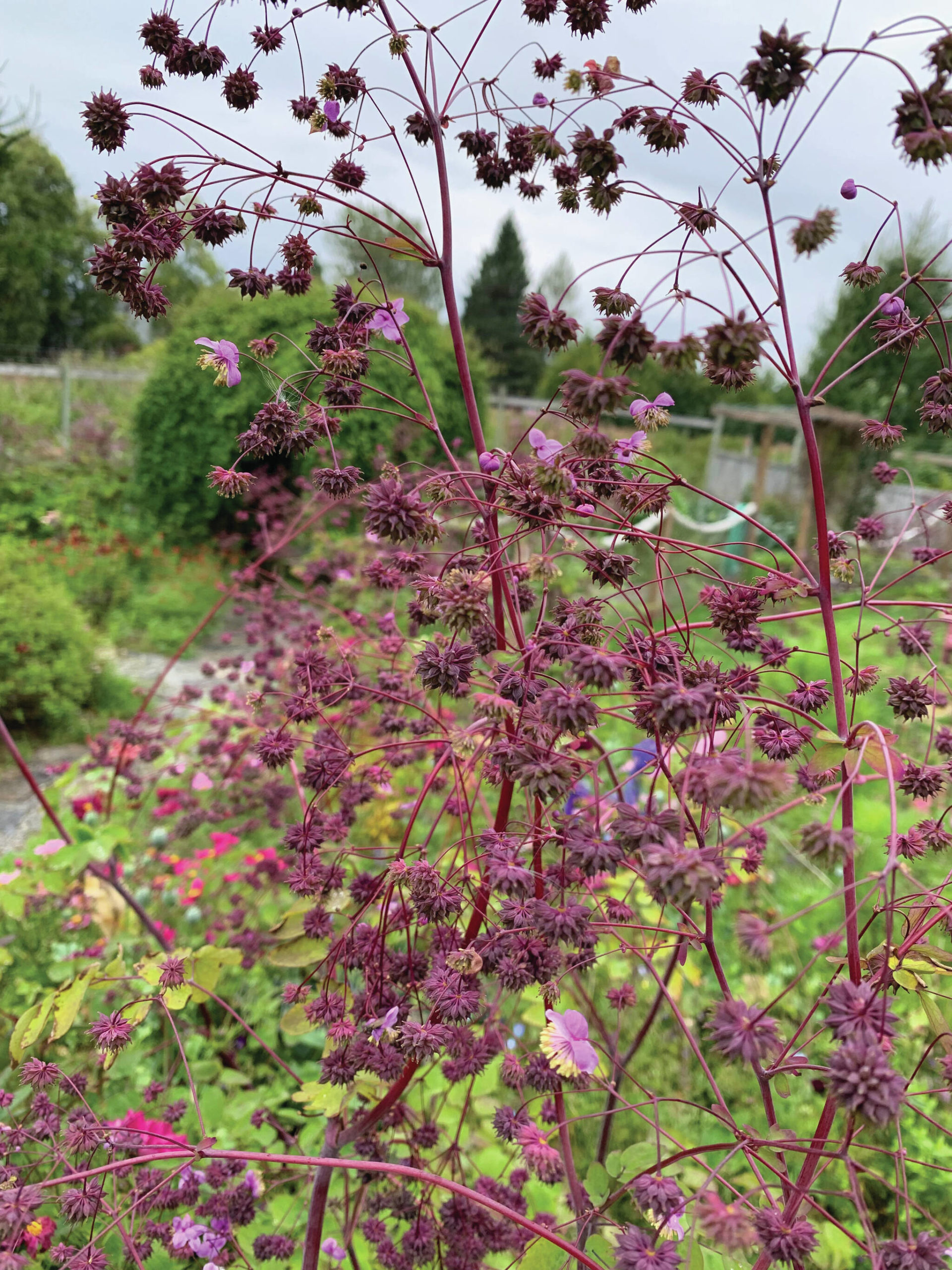It’s that magnificent time of year when you really should head north. No need to leave the peninsula — the colors are really lovely within 200 miles of us, just go. Pack a picnic, a camper if you have one, a tent if not, or make it a day trip. By heading north, you will follow the colors as they change, and on the way back, they will have intensified. Double the glory.
All of which, of course, leads to harvesting the vegetable garden. The purple cauliflower made it to the freezer first, followed by broccoli, Romanesque cauliflower, some peas (still maturing) and beans. The broccoli is still sending out side shoots, which are very tiny but tasty. The artichoke seems determined to produce a sizable bud. I’m wishing it luck. The green beans planted outside are not yet in bloom, but the greenhouse team seems inexhaustible. Why oh why do the Sugar Ann peas take forever to produce? But they are trying their best.
The shallots are drying in the basement along with the puny garlic that got harvested a couple of weeks earlier. I like to lay out the alliums (including onions that need more time before harvest this year, like most everything else) in a single layer on newspaper until completely dry. All of these will keep downstairs all winter, stored in either wicker baskets or brown paper bags. They are so worth the effort.
The carrots (Bolero) are gorgeous. This was the year I intended to plant them three weeks later than usual so as not to get 100-pound specimens. My neighbor, Rachel, inadvertently did this last year with great success, so I was inspired. Well, as you know, there was no choice but to wait the three weeks and these carrots are a perfect size. I’m very pleased. We’re just eating these fresh, too soon to harvest for the winter. We have an imperfect but better than nothing storage system that depends on the weather getting cold enough.
Same with the beets and purple cabbage.
The lettuce, Skyphos (it doesn’t seem to ever bolt), is holding its own — still. We now harvest just the center, taking the bigger tougher leaves for a walk to the compost. The spinach and chard put in an excellent effort and are now tucked into the freezer.
But I’m feeling very grateful that the harvest is looking as good as it is. The whole venture seemed quite shaky in May. Now it looks like we really could use more time, but it isn’t crucial.
For years and years I took the tomato overflow to friends here and there, but those friends are now successfully growing their own and are not at all interested in my ever-so-abundant harvest — from just three plants, I’ll add. Enter my neighbor Karen. She has been suggesting to me (for years and years) to stop giving them away and toss them in the freezer. Well, this is the year. I’ve attempted to roast them before freezing, twice. Have now reconsidered that step and am just freezing them. Our daughter, Andrea, suggested to halve and seed them or else they are too watery when the need arises to actually use them. I’m offering you this humble option for your surplus tomatoes, may the Force be with you.
So here we are at the perennial beds. The deadheading has stopped. It’s time to admit that the fat lady is about to sing. I will leave a few seed heads because the winter die off from last year put such a dent in the population that I’m trying to regroup. But too much of a good thing is just too much. The extra seed heads will go into a plastic bag and take a trip to the dump, not the compost. I also want to share some of the seeds from the thalictrum. It seemed that was the bloom that drew the most attention this season, probably because that was a predominant plant in an otherwise sparse garden. My neighbor, Louise, harvested a pale yellow/cream columbine seed that I admired in her garden and shared some with me.
Garden magazines suggest leaving seed heads for “winter interest.” Well, that can result in zillions of seedlings the coming season. Leaving a few will do the trick of the plant reseeding itself and offering you “winter interest.”
What I’ve learned about saving seeds is not to – at least not for long. Take the seeds and scatter them hither and yon now, don’t wait until spring. The plants themselves drop their seeds now so why not you? Get scattering. I’ve done this with the minor bulbs.
Which brings me to bulbs. Now is the time to get your bulb order in or take a look around our local nurseries. This is how I found camassia on the counter at the Wagon Wheel, and what a find. I love this plant and it is successfully spreading. Now I’m after wood hyacinths. They thrive in the Pacific Northwest and I’m thinking they would be lovely right here in Homer. Don’t forget fritillaria meleagris (checkered lily); they love it here.
This is also a good time to rethink some mistakes. We have an ornamental crab that has never thrived. It’s grafted to something or other and that other is sending up a million suckers, making the main trunk look grimmer every year. After about 20 years of being disappointed in this tree, it’s time for it to come down. It won’t be missed.
The leaves will be thinking about dropping. We don’t rake, just leave them in place and run the mower over them. Think about that. Also think about setting the blade higher on your mower, leaving the grass a bit longer to go into the fall month(s).
The growing season is far from over. Keep harvesting, keep weeding, keep mowing, keep moving.
Rosemary Fitzpatrick is a longtime Homer gardener and has been writing Kachemak Gardener since 1990.


